- Home
- Raymond Chandler
The Simple Art of Murder
The Simple Art of Murder Read online
* * *
RAYMOND
CHANDLER
* * *
THE SIMPLE ART OF MURDER
VINTAGE CRIME/BLACK LIZARD
VINTAGE BOOKS
A DIVISION OF RANDOM HOUSE, INC.
NEW YORK
CONTENTS
Title Page
The Simple Art of Murder: An Essay
Spanish Blood
I’ll Be Waiting
The King in Yellow
Pearls Are a Nuisance
Pickup on Noon Street
Smart-Aleck Kill
Guns at Cyrano’s
Nevada Gas
About the Author
Other Books By Raymond Chandler
About This Title
Copyright
* * *
THE SIMPLE ART OF MURDER
* * *
AN ESSAY
Fiction in any form has always intended to be realistic. Old-fashioned novels which now seem stilted and artificial to the point of burlesque did not appear that way to the people who first read them. Writers like Fielding and Smollett could seem realistic in the modern sense because they dealt largely with uninhibited characters, many of whom were about two jumps ahead of the police, but Jane Austen’s chronicles of highly inhibited people against a background of rural gentility seem real enough psychologically. There is plenty of that kind of social and emotional hypocrisy around today. Add to it a liberal dose of intellectual pretentiousness and you get the tone of the book page in your daily paper and the earnest and fatuous atmosphere breathed by discussion groups in little clubs. These are the people who make best sellers, which are promotional jobs based on a sort of indirect snob appeal, carefully escorted by the trained seals of the critical fraternity, and lovingly tended and watered by certain much too powerful pressure groups whose business is selling books, although they would like you to think they are fostering culture. Just get a little behind in your payments and you will find out how idealistic they are.
The detective story for a variety of reasons can seldom be promoted. It is usually about murder and hence lacks the element of uplift. Murder, which is a frustration of the individual and hence a frustration of the race, may have, and in fact has, a good deal of sociological implication. But it has been going on too long for it to be news. If the mystery novel is at all realistic (which it very seldom is) it is written in a certain spirit of detachment; otherwise nobody but a psychopath would want to write it or read it. The murder novel has also a depressing way of minding its own business, solving its own problems and answering its own questions. There is nothing left to discuss, except whether it was well enough written to be good fiction, and the people who make up the half-million sales wouldn’t know that anyway. The detection of quality in writing is difficult enough even for those who make a career of the job, without paying too much attention to the matter of advance sales.
The detective story (perhaps I had better call it that, since the English formula still dominates the trade) has to find its public by a slow process of distillation. That it does do this, and holds on thereafter with such tenacity, is a fact; the reasons for it are a study for more patient minds than mine. Nor is it any part of my thesis to maintain that it is a vital and significant form of art. There are no vital and significant forms of art; there is only art, and precious little of that. The growth of populations has in no way increased the amount; it has merely increased the adeptness with which substitutes can be produced and packaged.
Yet the detective story, even in its most conventional form, is difficult to write well. Good specimens of the art are much rarer than good serious novels. Second-rate items outlast most of the high-velocity fiction, and a great many that should never have been born simply refuse to die at all. They are as durable as the statues in public parks and just about as dull.
This fact is annoying to people of what is called discernment. They do not like it that penetrating and important works of fiction of a few years back stand on their special shelf in the library marked “Best-sellers of Yesteryear” or something, and nobody goes near them but an occasional shortsighted customer who bends down, peers briefly and hurries away; while at the same time old ladies jostle each other at the mystery shelf to grab off some item of the same vintage with such a title as The Triple Petunia Murder Case or Inspector Pinchbottle to the Rescue. They do not like it at all that “really important books” (and some of them are too, in a way) get the frosty mitt at the reprint counter while Death Wears Yellow Garters is put out in editions of fifty or one hundred thousand copies on the newsstands of the country, and is obviously not there just to say goodbye.
To tell the truth, I do not like it very much myself. In my less stilted moments I too write detective stories, and all this immortality makes just a little too much competition. Even Einstein couldn’t get very far if three hundred treatises of the higher physics were published every year, and several thousand others in some form or other were hanging around in excellent condition, and being read too.
Hemingway says somewhere that the good writer competes only with the dead. The good detective story writer (there must after all be a few) competes not only with all the unburied dead but with all the hosts of the living as well. And on almost equal terms; for it is one of the qualities of this kind of writing that the thing that makes people read it never goes out of style. The hero’s tie may be a little out of the mode and the good gray inspector may arrive in a dogcart instead of a streamlined sedan with siren screaming, but what he does when he gets there is the same old futzing around with timetables and bits of charred paper and who trampled the jolly old flowering arbutus under the library window.
I have, however, a less sordid interest in the matter. It seems to me that production of detective stories on so large a scale, and by writers whose immediate reward is small and whose meed of critical praise is almost nil, would not be possible at all if the job took any talent. In that sense the raised eyebrow of the critic and the shoddy merchandising of the publisher are perfectly logical. The average detective story is probably no worse than the average novel, but you never see the average novel. It doesn’t get published. The average—or only slightly above average—detective story does. Not only is it published but it is sold in small quantities to rental libraries and it is read. There are even a few optimists who buy it at the full retail price of two dollars, because it looks so fresh and new and there is a picture of a corpse on the cover.
And the strange thing is that this average, more than middling dull, pooped-out piece of utterly unreal and mechanical fiction is really not very different from what are called the masterpieces of the art. It drags on a little more slowly, the dialogue is a shade grayer, the cardboard out of which the characters are cut is a shade thinner, and the cheating is a little more obvious. But it is the same kind of book. Whereas the good novel is not at all the same kind of book as the bad novel. It is about entirely different things. But the good detective story and the bad detective story are about exactly the same things, and they are about them in very much the same way. There are reasons for this too, and reasons for the reasons; there always are.
I suppose the principal dilemma of the traditional or classic or straight deductive or logic and deduction novel of detection is that for any approach to perfection it demands a combination of qualities not found in the same mind. The coolheaded constructionist does not also come across with lively characters, sharp dialogue, a sense of pace, and an acute use of observed detail. The grim logician has as much atmosphere as a drawing board. The scientific sleuth has a nice new shiny laboratory, but I’m sorry I can’t remember the face. The fellow who can write you a vivid and colorful prose simply will not be bothe
red with the coolie labor of breaking down unbreakable alibis.
The master of rare knowledge is living psychologically in the age of the hoop skirt. If you know all you should know about ceramics and Egyptian needlework, you don’t know anything at all about the police. If you know that platinum won’t melt under about 3000° F. by itself, but will melt at the glance of a pair of deep blue eyes if you put it near a bar of lead, then you don’t know how men make love in the twentieth century. And if you know enough about the elegant flânerie of the pre-war French Riviera to lay your story in that locale, you don’t know that a couple of capsules of barbital small enough to be swallowed will not only not kill a man—they will not even put him to sleep if he fights against them.
Every detective story writer makes mistakes, of course, and none will ever know as much as he should. Conan Doyle made mistakes which completely invalidated some of his stories, but he was a pioneer, and Sherlock Holmes after all is mostly an attitude and a few dozen lines of unforgettable dialogue. It is the ladies and gentlemen of what Mr. Howard Haycraft(in his book Murder for Pleasure) calls the Golden Age of detective fiction that really get me down. This age is not remote. For Mr. Haycraft’s purpose it starts after the First World War and lasts up to about 1930. For all practical purposes it is still here. Two thirds or three quarters of all the detective stories published still adhere to the formula the giants of this era created, perfected, polished, and sold to the world as problems in logic and deduction.
These are stern words, but be not alarmed. They are only words. Let us glance at one of the glories of the literature, an acknowledged masterpiece of the art of fooling the reader without cheating him. It is called The Red House Mystery, was written by A. A. Milne, and has been named by Alexander Woollcott (rather a fast man with a superlative) “one of the three best mystery stories of all time.” Words of that size are not spoken lightly. The book was published in 1922 but is timeless, and might as easily have been published in July, 1939, or, with a few slight changes, last week. It ran thirteen editions and seems to have been in print, in the original format, for about sixteen years. That happens to few books of any kind. It is an agreeable book, light, amusing in the Punch style, written with a deceptive smoothness that is not so easy as it looks.
It concerns Mark Ablett’s impersonation of his brother Robert as a hoax on his friends. Mark is the owner of the Red House, a typical laburnum-and-lodge-gate English country house. He has a secretary who encourages him and abets him in this impersonation, and who is going to murder him if he pulls it off. Nobody around the Red House has ever seen Robert, fifteen years absent in Australia and known by repute as a no-good. A letter is talked about (but never shown) announcing Robert’s arrival, and Mark hints it will not be a pleasant occasion. One afternoon, then, the supposed Robert arrives, identifies himself to a couple of servants, is shown into the study. Mark goes in after him (according to testimony at the inquest). Robert is then found dead on the floor with a bullet hole in his face, and of course Mark has vanished into thin air. Arrive the police, who suspect Mark must be the murderer, remove the debris, and proceed with the investigation—and in due course, with the inquest.
Milne is aware of one very difficult hurdle and tries as well as he can to get over it. Since the secretary is going to murder Mark, once Mark has established himself as Robert, the impersonation has to continue and fool the police. Since, also, everybody around the Red House knows Mark intimately, disguise is necessary. This is achieved by shaving off Mark’s beard, roughening his hands (“not the hands of a manicured gentleman”—testimony), and the use of a gruff voice and rough manner.
But this is not enough. The cops are going to have the body and the clothes on it and whatever is in the pockets. Therefore none of this must suggest Mark. Milne therefore works like a switch engine to put over the motivation that Mark is such a thoroughly conceited performer that he dresses the part down to the socks and underwear (from all of which the secretary has removed the maker’s labels), like a ham blacking himself all over to play Othello. If the reader will buy this (and the sales record shows he must have), Milne figures he is solid. Yet, however light in texture the story may be, it is offered as a problem of logic and deduction.
If it is not that, it is nothing at all. There is nothing else for it to be. If the situation is false, you cannot even accept it as a light novel, for there is no story for the light novel to be about. If the problem does not contain the elements of truth and plausibility, it is no problem; if the logic is an illusion, there is nothing to deduce. If the impersonation is impossible once the reader is told the conditions it must fulfill, then the whole thing is a fraud. Not a deliberate fraud, because Milne would not have written the story if he had known what he was up against. He is up against a number of deadly things, none of which he even considers. Nor, apparently, does the casual reader, who wants to like the story—hence takes it at its face value. But the reader is not called upon to know the facts of life when the author does not. The author is the expert in the case.
Here is what this author ignores:
1. The coroner holds formal jury inquest on a body for which no legal competent identification is offered. A coroner, usually in a big city, will sometimes hold inquest on a body that cannot be identified, if the record of such an inquest has or may have a value (fire, disaster, evidence of murder). No such reason exists here, and there is no one to identify the body. Witnesses said the man said he was Robert Ablett. This is mere presumption, and has weight only if nothing conflicts with it. Identification is a condition precedent to an inquest. It is a matter of law. Even in death a man has a right to his own identity. The coroner will, wherever humanly possible, enforce that right. To neglect it would be a violation of his office.
2. Since Mark Ablett, missing and suspected of the murder, cannot defend himself, all evidence of his movements before and after the murder is vital (as also whether he has money to run away on); yet all such evidence is given by the man closest to the murder and is without corroboration. It is automatically suspect until proved true.
3. The police find by direct investigation that Robert Ablett was not well thought of in his native village. Somebody there must have known him. No such person was brought to the inquest. (The story couldn’t stand it.)
4. The police know there is an element of threat in Robert’s supposed visit, and that it is connected with the murder must be obvious to them. Yet they make no attempt to check Robert in Australia, or find out what character he had there, or what associates, or even if he actually came to England, and with whom. (If they had, they would have found out he had been dead three years.)
5. The police surgeon examines a body with a recently shaved beard (exposing unweathered skin) and artificially roughened hands, but it is the body of a wealthy, soft-living man, long resident in a cool climate. Robert was a rough individual and had lived fifteen years in Australia. That is the surgeon’s information. It is impossible he would have noticed nothing to conflict with it.
6. The clothes are nameless, empty, and have had the labels removed. Yet the man wearing them asserted an identity. The presumption that he was not what he said he was is overpowering. Nothing whatever is done about his peculiar circumstance. It is never even mentioned as being peculiar.
7. A man is missing, a well-known local man, and a body in the morgue closely resembles him. It is impossible that the police should not at once eliminate the chance that the missing man is the dead man. Nothing would be easier than to prove it. Not even to think of it is incredible. It makes idiots of the police, so that a brash amateur may startle the world with a fake solution.
The detective in the case is an insouciant amateur named Anthony Gillingham, a nice lad with a cheery eye, a nice little flat in town, and that airy manner. He is not making any money on the assignment, but is always available when the local gendarmerie loses its notebook. The English police endure him with their customary stoicism, but I shudder to think what the boys down
at the Homicide Bureau in my city would do to him.
There are even less plausible examples of the art than this. In Trent’s Last Case (often called “the perfect detective story”) you have to accept the premise that a giant of international finance, whose lightest frown makes Wall Street quiver like a chihuahua, will plot his own death so as to hang his secretary, and that the secretary when pinched will maintain an aristocratic silence—the old Etonian in him, maybe. I have known relatively few international financiers, but I rather think the author of this novel has (if possible) known fewer.
There is another one, by Freeman Wills Crofts (the soundest builder of them all when he doesn’t get too fancy), wherein a murderer, by the aid of make-up, split-second timing and some very sweet evasive action, impersonates the man he has just killed and thereby gets him alive and distant from the place of the crime. There is one by Dorothy Sayers in which a man is murdered alone at night in his house by a mechanically released weight which works because he always turns the radio on at just such a moment, always stands in just such a position in front of it, and always bends over just so far. A couple of inches either way and the customers would get a rain check. This is what is vulgarly known as having God sit in your lap; a murderer who needs that much help from Providence must be in the wrong business.
And there is a scheme of Agatha Christie’s featuring M. Hercule Poirot, that ingenious Belgian who talks in a literal translation of school-boy French. By duly messing around with his “little gray cells” M. Poirot decides that since nobody on a certain through sleeper could have done the murder alone, everybody did it together, breaking the process down into a series of simple operations like assembling an egg beater. This is the type that is guaranteed to knock the keenest mind for a loop. Only a halfwit could guess it.

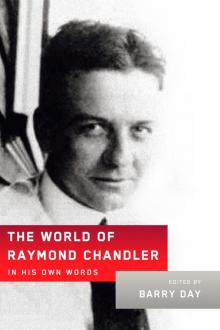 The World of Raymond Chandler: In His Own Words
The World of Raymond Chandler: In His Own Words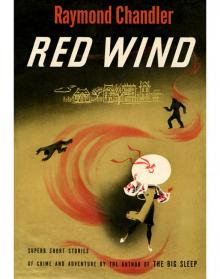 Red Wind: A Collection of Short Stories
Red Wind: A Collection of Short Stories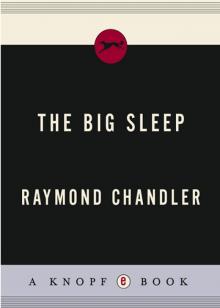 The Big Sleep
The Big Sleep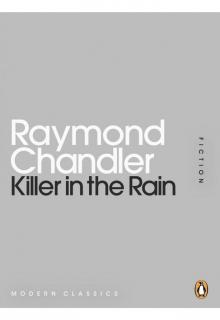 Killer in the Rain
Killer in the Rain Playback
Playback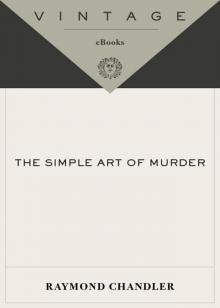 The Simple Art of Murder
The Simple Art of Murder The Bronze Door
The Bronze Door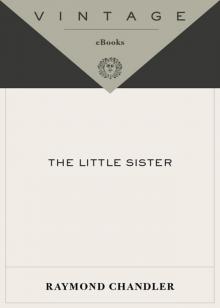 The Little Sister
The Little Sister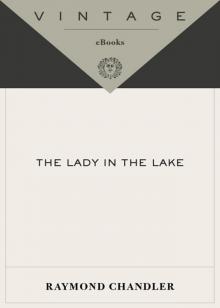 The Lady in the Lake
The Lady in the Lake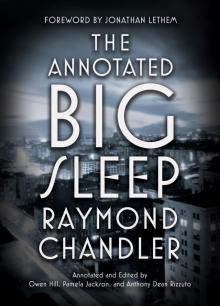 The Annotated Big Sleep
The Annotated Big Sleep The Collected Raymond Chandler
The Collected Raymond Chandler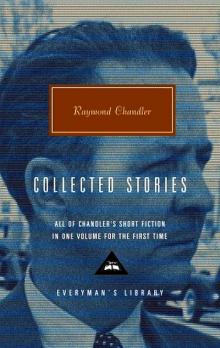 Collected Stories (Everyman's Library)
Collected Stories (Everyman's Library)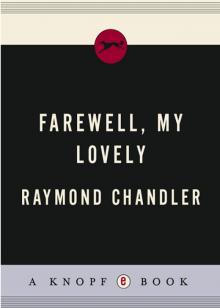 Farewell, My Lovely
Farewell, My Lovely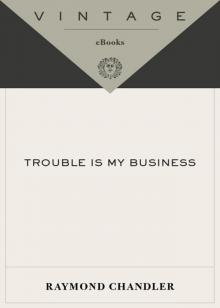 Trouble Is My Business
Trouble Is My Business The Long Goodbye
The Long Goodbye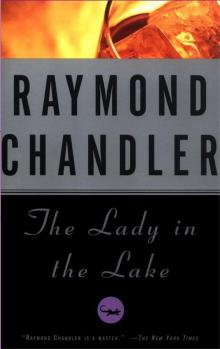 The Lady in the Lake pm-4
The Lady in the Lake pm-4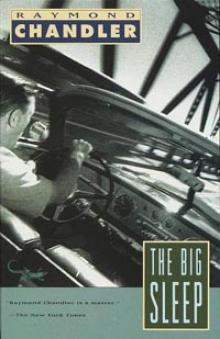 The Big Sleep pm-1
The Big Sleep pm-1 The World of Raymond Chandler
The World of Raymond Chandler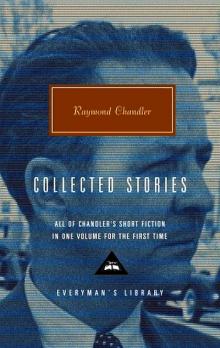 Collected Stories of Raymond Chandler
Collected Stories of Raymond Chandler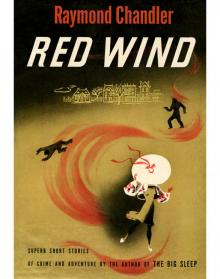 Red Wind
Red Wind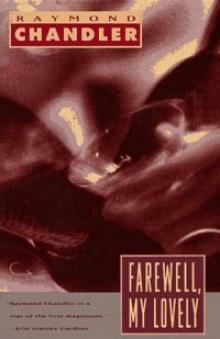 Farewell, My Lovely pm-2
Farewell, My Lovely pm-2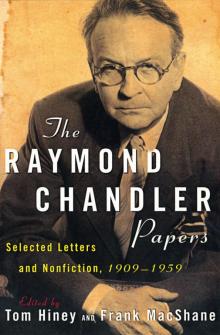 The Raymond Chandler Papers: Selected Letters and Nonfiction, 1909–1959
The Raymond Chandler Papers: Selected Letters and Nonfiction, 1909–1959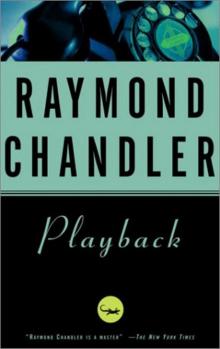 Playback pm-7
Playback pm-7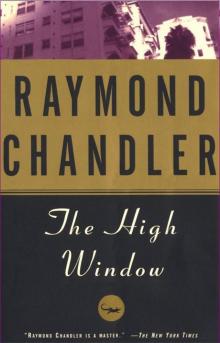 The High Window pm-3
The High Window pm-3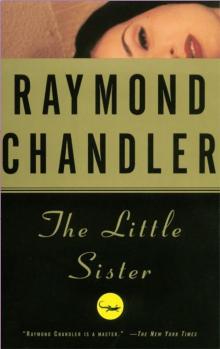 The Little Sister pm-5
The Little Sister pm-5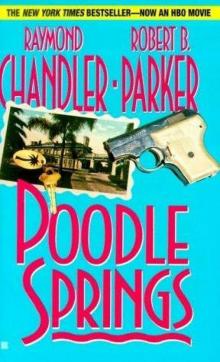 Poodle Springs (philip marlowe)
Poodle Springs (philip marlowe)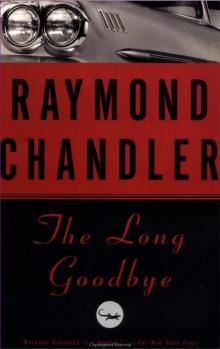 The Long Goodbye pm-6
The Long Goodbye pm-6